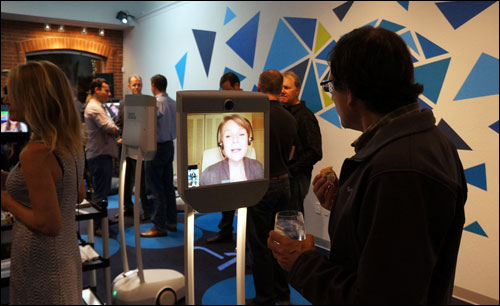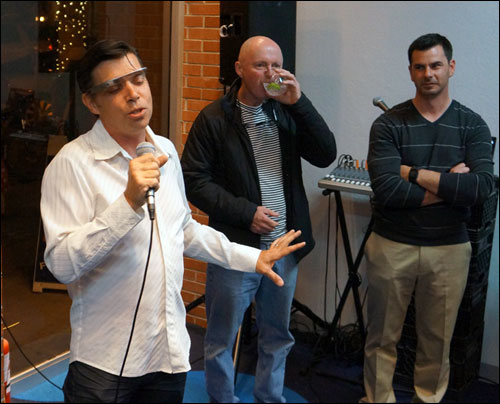As soon as I sat down with Scott Hassan at the opening party for his company’s pop-up store, located at an enviable location in Palo Alto’s busy University Ave. corridor, he looked slightly away from me, as if into space, and gently bobbed his head up and to the right. It took me a millisecond to realize what he was doing: responding to some alert in his Google Glass viewfinder. Ironically, his company, Suitable Technologies, makes a product that uses technology to improve person-to-person—not person-to-wearable-computer—communication.
The BeamPro, the firm’s flagship product, is a robot with motorized wheels, as well as a video monitor, a camera, a speaker and microphones mounted on a pair of 4-foot-tall support posts rising from its base. It’s designed to enable any person anywhere in the world to “beam into” the robot’s physical location. In do doing, the user can visit with other people in the vicinity of the robot via a two-way video feed (similar to a Skype video call), navigate the device through that space, and interact visually and audibly within that defined area.
To use the BeamPro, all a person needs is a computer running the Beam software, as well as a reliable Wi-Fi connection, a webcam, a microphone and speakers. The company is opening its first pop-up shop, through which it is selling its latest product, the Beam+. A scaled-down iteration of the BeamPro, the Beam+ is designed for consumers. It features a 10-inch video monitor, which is 7 inches smaller than that of the BeamPro. Its battery lasts for only two hours of usage before requiring a recharge, compared with the Pro’s eight hours. And it has only a single Wi-Fi radio, compared to the two built into the Pro, to ensure constant connectivity even within a large office.
Hassan said several Fortune 500 companies own BeamPros and keep them at corporate headquarters to allow executives to attend meetings virtually while out of town, or to facilitate meetings with clients, as an alternative to in-the-flesh meetings. (Due to non-disclosure agreements, he said, he could not reveal the names of these firms.) Payment company Square has been vocal about its use of BeamPro to do the same, as has entrepreneur Peter H. Diamandis, the chairman and CEO of X Prize Foundation, who filmed a testimonial that can be viewed on YouTube:
Suitable Technologies is not looking to compete against virtual meeting services, such as Cisco’s TelePresence, a virtual conferencing tool, Hassan noted. “TelePresence works great for meetings in which groups of people on either end need to speak to each other,” he explained, “but the Beam is great for enabling an individual to be inside a different space.”
Edward Snowden, the National Security Agency (NSA) whistle blower, beamed into the TED2014 conference from an undisclosed location in Russia, in order to participate in an on-stage interview. Individuals with disabilities have also been using the Beam and other telepresence and robotics technologies, for adaptive applications. Henry Evens, a quadriplegic who lives in Palo Alto, Calif., used Beam for a TEDx Mid-Atlantic event last year. (TED is a well-known conference series about technology entertainment and design, while TEDx events are local offshoots of the main TED annual conference.)
In business settings, a person can Beam into a number of different meetings, at different locations, across a corporate campus throughout a given day, by simply “driving” the BeamPro from conference room to cubicle to corner office. However, he or she would need someone to escort the BeamPro on elevator trips, since the robot lacks actuators or appendages that would enable it to do things like press buttons. There are two cameras on the Beam (either model). One faces forward, while the second is oriented straight down, thereby giving the user a view of the area immediately in front of the Beam’s base, in order to see if anything or anyone is directly in the device’s path. To store and recharge the Beam, a person uses her computer to direct the machine into its charging dock. Once the robot is docked, an indicator on the user’s computer screen shows that the Beam is charging.
At the pop-up shop party in Palo Alto, I spoke with a handful of individuals who were Beaming into the party from other locations, and was struck by how easily I could hear them speaking and vice versa, despite the din of background noise throughout the room. This, Hassan explained, was achieved by setting the microphones embedded around the monitor for optimal pick-up in the immediate foreground of the monitor, while turning off some of the mics to the side and behind it.
While at the party in California, I also test-drove a BeamPro located 1,500 miles away, in Suitable Technologies’ satellite office in Kansas City, Mo. Via an X-Box controller attached to a computer, I used one key to accelerate and another to turn in any direction. (Hassan said most users actually drive using the direction keys on their computer keyboard, as this video demonstrates.) I found the Beam easy to move and turn, though pushing a soccer ball into a goal—which staff members had set up as a way to test out operating the BeamPro for precise movements—took me three tries.
As an optional add-on feature, Suitable Technologies offers a LIDAR sensor integrated into the base of the BeamPro and linked to the Beam software. LIDAR, which stands for Light Detection and Ranging, is remote sensing technology that uses pulsed laser light to measure distances between the sensor and any objects in its path. The software utilizes the LIDAR to override a user’s input and slow the BeamPro to a stop before it encounters an object in its path. While the company may opt to add actuators and mechanical arms or other devices to enable Beam users to physically interact with items through the machine, Hassan says that in the short term, he is more focused on enabling interactions between people and helping them move throughout a space. “We call it smart presence,” he said.
Use Cases
Erin Rapacki, Suitable Technologies’ director of marketing, told me most popular use cases for Beams are currently based either on face-to-face meetings or demonstrations. “Companies with distributed teams, like Square, use Beam for collaboration and meetings,” she explained. Executives who travel and want to be in two places at once use them, like Diamandis does. A doctor who runs two clinics located 100 miles apart uses a BeamPro to check in with employees and sometimes patients.
But some unusual uses are also emerging, Rapacki said. For example, a real-estate agency in Southern California purchased a BeamPro to enable prospective homebuyers based in Asia to take self-directed tours of the interior of houses for sale. “We even had a CEO of a Chinese manufacturing company that sells white-label goods use a BeamPro to prove to some of his customers that he actually runs his own factory,” he stated.
Bo Preising, Suitable Technologies’ VP of engineering, told me one of the top concerns among executives who use BeamPros is security. Beam software employs Secure Sockets Layer (SSL) encryption to secure the video stream.
In the future, Hassan said, Suitable Technologies plans to evolve into a services company rather than just a seller of hardware. For example, it might eventually sell health-care services for elderly people who wish to continue living independently but need to check in regularly with their physicians or children. In this scenario, a user (or his or her family) would lease the BeamPro and pay fees for the connectivity services—such as a doctor beaming in to answer questions or make visual assessments (perhaps in addition to checking vital signs, collected through sensors worn by the patient) that the system enables.
Once Beam is installed within a home, Hassan envisions the provision of ancillary services, such as allowing a home-security service to access the Beam in the event that a security alarm or smoke detector is triggered. Those types of services could be offered either through the BeamPro or the new Beam+ model, designed specifically for consumer use.
“We think this will be the first remotely operated retail store,” Hassan said of the pop-up shop, which Suitable Technologies will run until March 2015. “No [sales clerks] will he here in meat form,” he added, but will instead beam into the store from elsewhere and assist customers, who will be experiencing how the Beam works from the “Beamee” point of view—but who will also be able to test-drive Beams located elsewhere, thereby becoming the “Beamer.”
As for whether Scott(y) Hassan will ever start Beaming users up onto intergalactic spaceships, as a certain Scottish engineer did on the 1960s TV series Star Trek… it’s too soon to tell. But for now, his company’s use of the Internet of Things is certainly an enterprising one.



